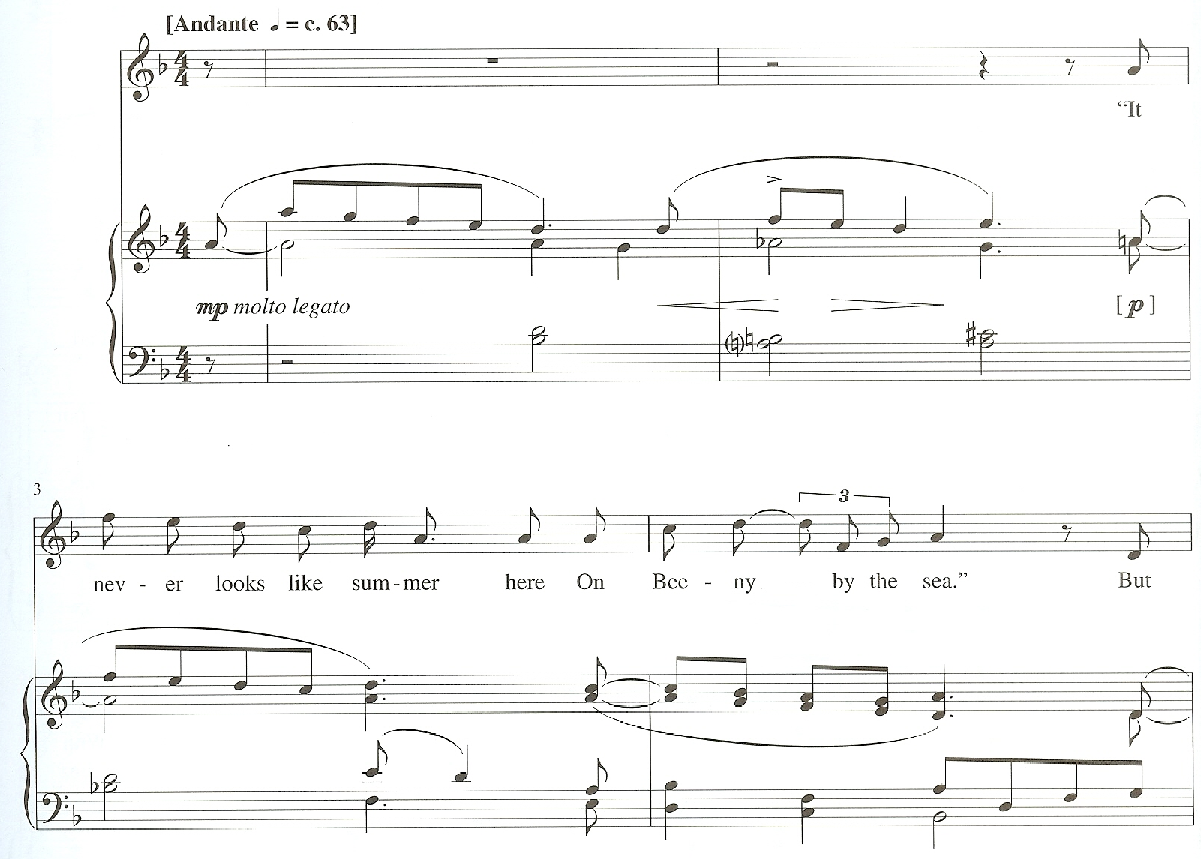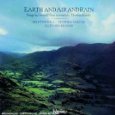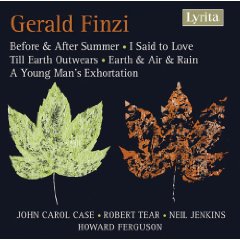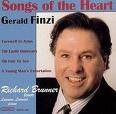It never looks like summer
- Musical Analysis Section
- Audio Recordings Section
- Unpublished Analysis Excerpts
- Gerhardus Daniël Van der Watt - The Songs of Gerald Finzi (1901-1956) To Poems by Thomas Hardy
- Mark Carlisle - Gerald Finzi: A performance Analysis of A Young Man's Exhortation and Till Earth Outwears, Two Works for High Voice and
- Leslie Alan Denning - A Discussion and Analysis of Songs for the Tenor Voice Composed by Gerald Finzi with Texts by Thomas Hardy
Poet: Thomas Hardy
Date of poem: Boscastle - 8 March 1913 (Hardy, 508)
Publication date: In the collection: Moments of Vision (November 30, 1917)
(Bailey, 339)
Publisher: Macmillan Publishing Company
Collection: Moments of Vision and Miscellaneous Verses (1917)
History of Poem: Richard Little Purdy records the date as to when the poem was written as March 8, 1913 at Boscastle. He goes on to say, "Hardy was revisiting the scenes of his courtship in Cornwall. Among his papers in the Dorset County Museum is a pencil drawing on which he has written 'Beeny Cliff, in the rain - Aug. 22, 1870 'It never looks like summer' - E.L.G. [Emma Lavinia Gifford] (on Beeny)." (Purdy, 202)
Poem
| 1 | ‘IT never looks like summer here | a |
| 2 | On Beeny by the sea.’ | b |
| 3 | But though she saw its looks as drear, | a |
| 4 | Summer it seemed to me. | b |
| 5 | It never looks like summer now | c |
| 6 | Whatever weather’s there; | d |
| 7 | But ah, it cannot anyhow, | c |
| 8 | On Beeny or elsewhere! | d |
(Hardy, 507-8) |
||
Content/Meaning of the Poem:
1st stanza: It never looks like summer on Beeny shore, even though she thought so I didn't think it so.
2nd stanza: It never looks like summer now no matter the weather there; and I don't believe it ever will on Beeny or anywhere else!
For additional comments as to possible meaning of the text please refer to: Content - Van der Watt.
Speaker: Thomas Hardy
Setting: 1st stanza - Beeny Cliff in 1870. 2nd stanza - Beeny Cliff in 1913.
Purpose: To remember Emma Hardy, Thomas Hardy's first wife.
Idea or theme: Lost love
Style: Gerhardus Daniël Van der Watt comments in his dissertation that the poem has "pastoral characteristics" but its style may be closer to a "lament brought about in the face of painful memories." (Van der Watt, 393)
Form: Gerhardus Daniël Van der Watt records the form of the poem as having "two quatrains with lines of uneven length. The rhyme scheme is simple rounded: abab cdcd and the metre is iambic with small deviations in lines four and eight." (Van der Watt, 393)
Synthesis: This poem is another of those that Hardy wrote after the death of his first wife, Emma and as such it possibly helped him work through the grieving process. As one might expect writing about a loved one that has passed away must have been difficult and to compound the difficulty the memory that is revisited reminded Hardy that the two of them were not always compatible. Consider the lyrics, " ‘It never looks like summer here On Beeny by the sea.’ But though she saw its looks as drear, Summer it seemed to me." One can imagine the tone in which Emma delivered the first two lines, ‘It never looks like summer here On Beeny by the sea’ and then probably how Hardy had to smooth things over or possibly cut the time short that he had at Beeny Cliffs to enjoy the sea all the while thinking to himself that "Summer it seemed to me." In the second stanza the pain of losing Emma is brought to the forefront and Hardy openly grieves her passing, "It never looks like summer now . . . On Beeny or elsewhere!" This poem clearly references how touched Hardy must have been by re-visiting the site.
Gerhardus Daniël Van der Watt commented in his dissertation that, "This small-scale pastoral lament, yearning for the past, when through the eyes of love the world was sunny summer all the time, is another example of the process of memory at work in Thomas Hardy. Now, in the evening of his life, little more than memories remain and he would make these into poems, to preserve them against time. The simple form and understated content gives the poem its expressive power." (Van der Watt, 393)
Published comments about the poem: F. B. Pinion suggests comparing this poem to The Figure in the Scene. Pinion goes on to say: "Hardy's pencil sketch of [The figure in the Scene] has written under it: 'Beeny Cliff, in the rain - Aug. 22, 1870." (Pinion, 147)
✦✼✦✼✦✼✦✼✦✼✦✼✦✼✦✼✦✼✦✼✦✼✦✼✦✼✦✼✦✼✦✼✦✼✦
Moments of Vision
- Collection of 160 poems written by Thomas Hardy.
- Published in November of 1917 by Macmillan and Company.
- This volume is the largest collection of poems Hardy published.
- 15 of the poems had been previously published. Nine within Selected Poems of Thomas Hardy.
- The collection contains several poems attributable to the loss of Hardy's first wife Emma.
- Hardy inscribed a copy to Florence Hardy, his second wife. "From Thomas Hardy, this first copy of the first edition, to the first of women Florence Hardy. Nov. 1917"
(Wright, 220)
Hardy commented about the volume saying, "I do not expect much notice will be taken of these poems; they mortify the human sense of self-importance by showing, or suggesting, that human beings are of no matter or appreciable value in this nonchalant universe." (Pinion, 120)
F. B. Pinion comments about the poetry saying, "most are reminiscent; many are inspired by the memory of Emma Hardy." (Pinion, 120)
Gerald Finzi set the following poems within this collection:
- At Middle-Field Gate in February (I Said To Love)
- The Clock of the Years (dated: 1916) (Earth and Air and Rain)
- For Life I Had Never Cared Greatly (I Said To Love)
- In the time of 'The Breaking of Nations' [titled by Finzi as: Only a man harrowing clods]
- It Never Looks Like Summer (dated: March 8, 1913) (Till Earth Outwears)
- Life Laughs Onward (Till Earth Outwears)
- Overlooking The River Stour [titled by Finzi as: Overlooking the River] (Before and After Summer)
- The Oxen ( By Footpath and Stile)
- Paying Calls (By Footpath and Stile)
- Transformations (A Young Man's Exhortation)
- While Drawing in a Churchyard [titled by Finzi as; In a Churchyard] (Earth and Air and Rain)
Helpful Links:
✦✼✦✼✦✼✦✼✦✼✦✼✦✼✦✼✦✼✦✼✦✼✦✼✦✼✦✼✦✼✦✼✦✼✦
Musical Analysis
Composition date: 1956
Publication date: © Copyright © 1958 by Boosey & Co. Ltd.
Publisher: Boosey & Hawkes - distributed by Hal Leonard Corporation
Tonality: The song is only fourteen measures long but in its brevity Finzi has managed to create some interesting tonal ambiguity. He begins in D minor and ends in F Major but in between there is some difficulty determining what key if any Finzi was going for. The difficulty in determining the tonal center briefly begins in measures five and six where one will see a chromatic bass line (see example below).
Chromatic bass line in measures 5-6. (Finzi, 98)
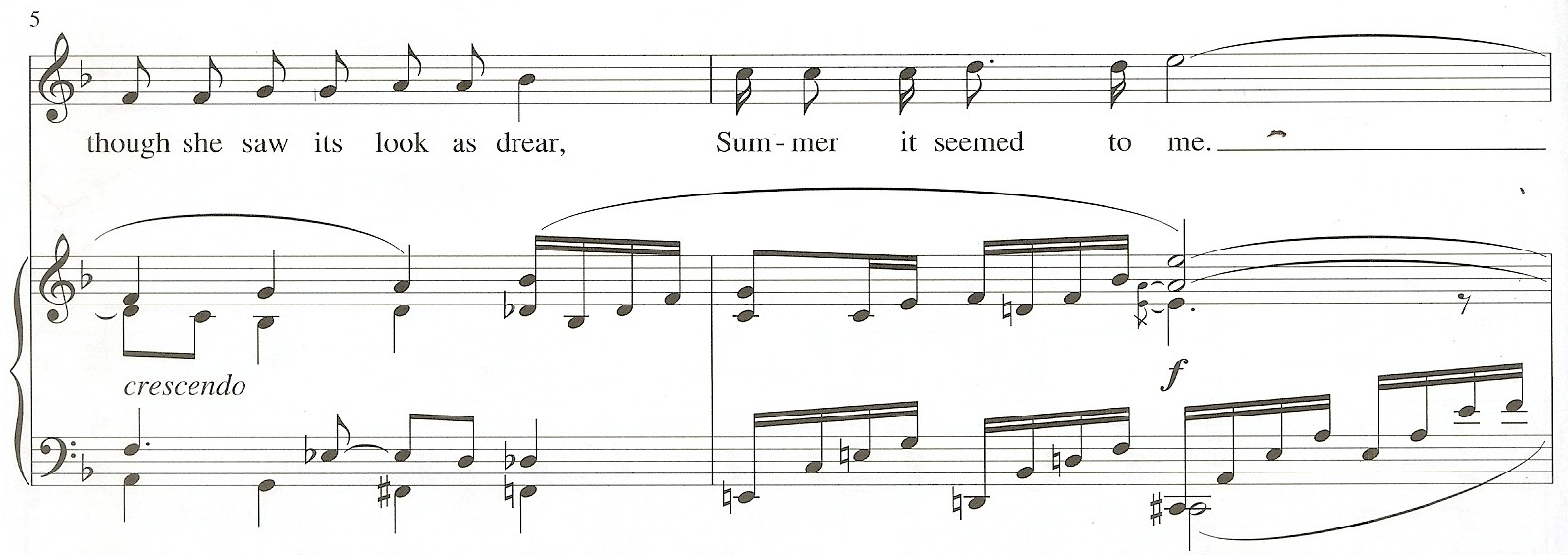
Beginning in measure nine through the remaining six measures there is no tonal direction at all and the cadence in F major is a complete surprise (see example below).
Tonal ambiguity in measures 9-14. (Finzi, 99)
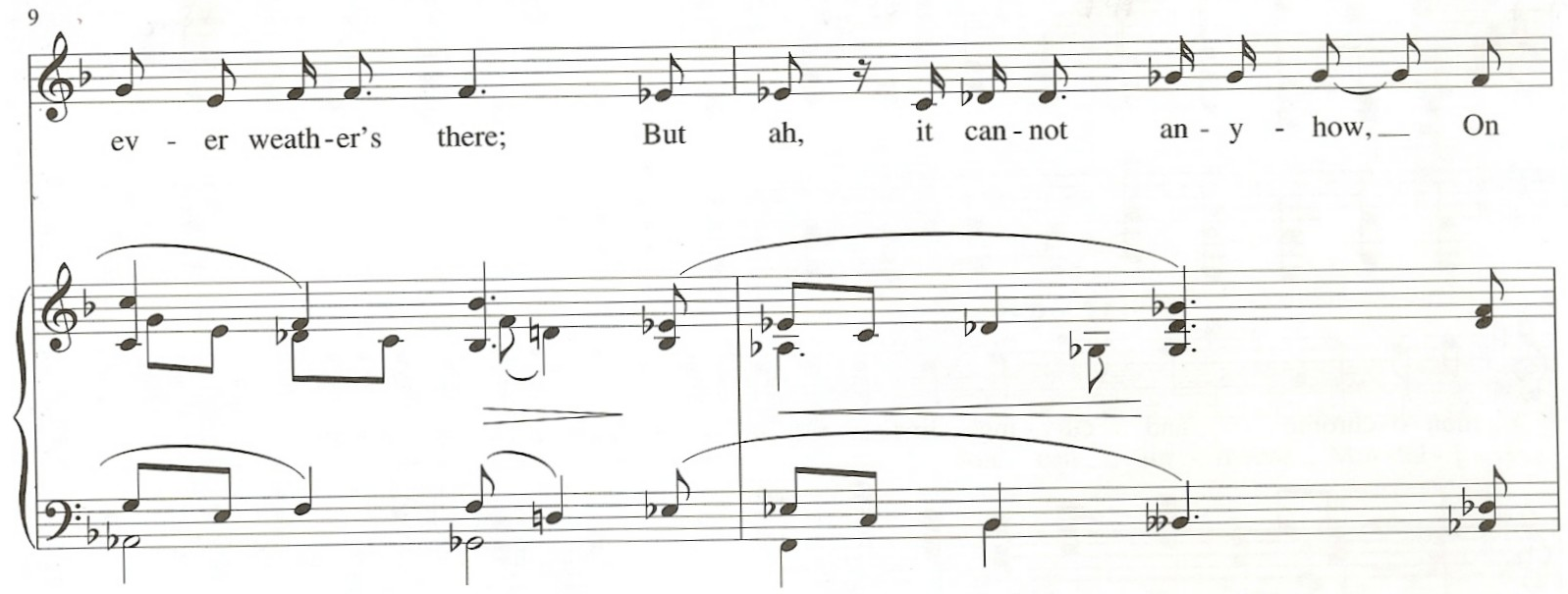
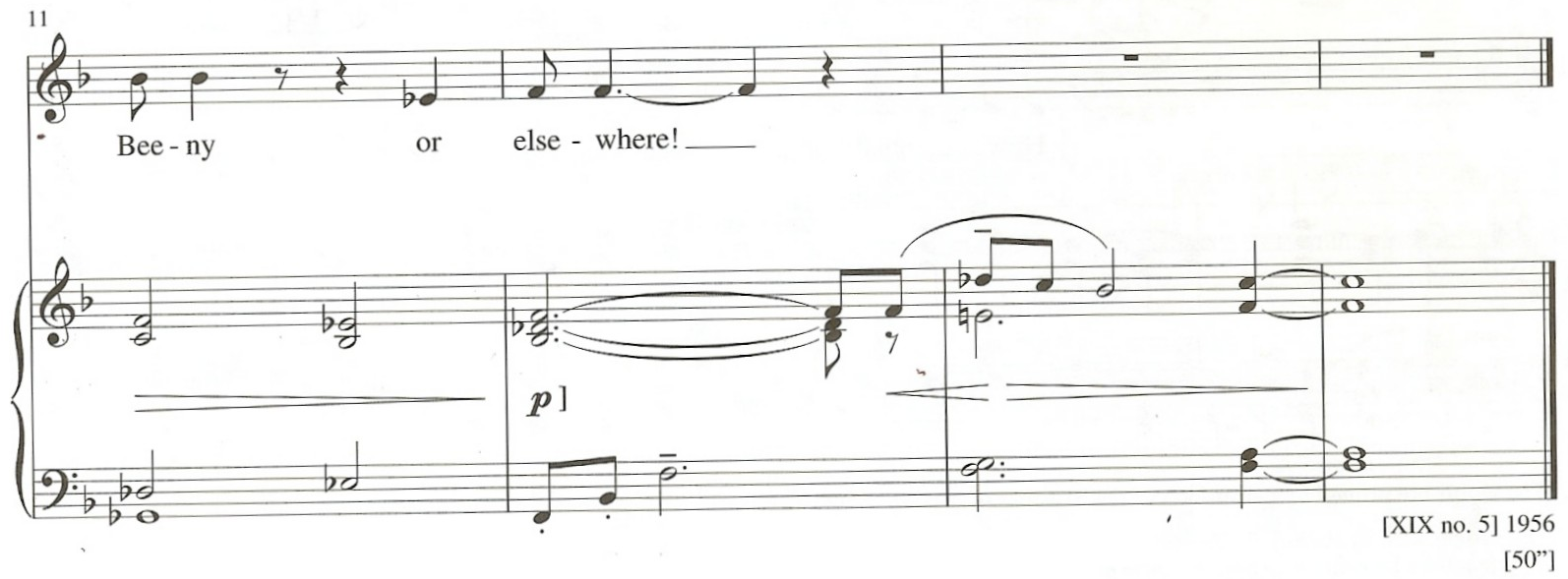
Gerhardus Daniël Van der Watt comments in his dissertation that, "the first eight bars of the song are clearly in D minor but from bar nine the tonality becomes fuzzy. There is a tendency towards the flat direction and it seems to settle in D flat major and its relative minor key, b flat minor and ends surprisingly on an F major chord which creates an imperfect feeling, if not cadence in the b flat minor context." (Van der Watt, 396) Mark Carlisle is almost in complete agreement with Dr. Van der Watt's analysis but believes B-flat minor is "strongly indicated in the last six measure." (Carlisle, 60)To view Dr. Carlisle's comments please refer to: Tonality - Carlisle. To view Dr. Van der Watt's remarks please refer to: Tonality - Van der Watt.
Transposition: The song is available a minor third lower than the original key. The transposed version may be found in the Medium/Low Voice edition by Boosey & Hawkes entitled: Gerald Finzi Collected Songs 54 Songs Including 8 Cycles or Sets.
Duration: Approximately one minute and eight seconds.
Meter: The meter is in 4/4 throughout. For additional comments about the meter within the song please refer to: Metre - Van der Watt.
Tempo: The opening indication for the song is Andante with the quarter note equalling c. 63. There is one deviation from the opening tempo and that is found in measure seven where a ritard is indicated. Thus helping facilitate a transition back to the opening theme in the accompaniment. A tempo is indicated at the beginning of measure ten and there are no further deviations. For additional comments about the tempi please refer to: Speed - Van der Watt.
Form: Mark Carlisle in his analysis of the song writes, "the song contains two clear sections that delineate the two brief poetic stanzas suggesting an antecedent/consequent relationship. Each section begins with the same melodic motive in the vocal line, but beyond this motive, there is little harmonically or melodically that is similar between the two sections." (Carlisle, 59-60) Gerhardus Daniël Van der Watt comments in his analysis that the song could be described as having a "varied strophic structure." This description is certainly plausible with regards to the vocal line because the beginning of each stanza is exactly the same (see example below).
Comparison of the beginning of each stanza's vocal line. (Finzi, 98-9)
(1st stanza measures 2-3) 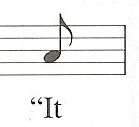

(2nd stanza measures 7-8) 
After the beginning of each stanza the vocal line and the accompaniment behave quite differently for each verse and compounding matters, in determining the form, is a repetitive theme that is heard three times, once in the piano prelude and twice in the vocal line and accompaniment. With all of these variables in mind a description of through-composed with thematic material seems best. To view Dr. Van der Watt's comments about the form of the song please refer to: Structure - Van der Watt. To view Dr. Carlisle's comments about the form please refer to: Comments on the Music - Carlisle.
Rhythm: The choice of rhythms are typical for Finzi in the song but there are a few rhythmic patterns that he utilizes in setting the text that are worthy of mentioning. Hardy has used the word "summer" three times in the poem and twice Finzi uses the same pattern of sixteenth note followed by a dotted eighth (see examples above in the Form category) for the two syllables but nearing the end of the first stanza he shortens the second syllable and thereby energizes the vocal line in support of the text (see example below).
Text setting of the word "summer" in measure 8. (Finzi, 99)

Finzi's use of creative rhythmic patterns is more adventurous in the concluding lines of the second stanza as he inserts longer rhythmic durations and a few rests in order to slow down the forward momentum so as to accommodate the heaviness and loss in Hardy's text (see example below).
Text setting in measures 9-12. (Finzi, 99)


The most common rhythmic duration used in the vocal line is the eighth note. Finzi has chosen to use longer rhythmic durations at the end of each stanza as if continuing the thought on for the listener and he really slows things down in the accompaniment from measure eleven to the end. A fairly typical device of Finzi's is to beam sixteenth notes together in the accompaniment when he wants to energize the song. Finzi does this beginning on the fourth beat of the fifth measure continuing on through the first beat of measure seven. The most common rhythmic pattern can be found in the opening theme, where Finzi uses five eighth notes followed by a dotted quarter note, it can be found five times in the song either exactly as described above or a slight variation. The last time it occurs it resembles a cascade of eighth notes tumbling down as one line in the accompaniment shares the pattern with another (see example below).
Rhythmic motive cascading in piano accompaniment in measures 7-10. (Finzi, 99)


For additional discussion about the rhythm and the rhythmic motifs of the song please refer to: Rhythm - Van der Watt.
A rhythmic duration analysis was also performed and for the results please refer to: Rhythm Analysis. Information contained within the analysis includes: the number of occurrences a specific rhythmic duration was used; the phrase in which it occurred; the total number of occurrences in the entire song.
Melody: After one considers the opening melodic line found in both the accompaniment and the vocal line there is not a lot of melodic movement in the song. The vocal line utilizes a lot of stepwise motion and unison pitches and Gerhardus Daniël Van der Watt comments that, "the fairly high incidence of repeated pitches gives the song a parlando character in arioso style." (Van der Watt, 395) He goes on to say that because of the frequency of the small intervals as well as unison pitches when Finzi uses a larger interval it has more significance. (Van der Watt, 395) The largest interval in the vocal line occurs at the beginning of both stanzas where Finzi writes minor sixth on the text, "It never." The majority of the other large intervals are descending and there significance is minor. What is more significant than the intervals used in the song is the use of chromatic writing in measures 9-14. Finzi's melodic and harmonic writing, in these measures, combine to create the aural image of pain and suffering from the loss of Hardy's first wife Emma (see example below).
Chromatic writing in measures 9-14. (Finzi, 99)


For additional information about the melodic material within the song please refer to: Melody - Van der Watt.
An interval analysis was performed for the purpose of discovering the number of occurrences specific intervals were used and also to see the similarities if there were any between stanzas. Only intervals larger than a major second were accounted for in the interval analysis. For a complete description of the results of the interval analysis please see the table at the bottom of the page or click on: Interval Analysis.
Texture: The texture is primarily homophonic but at the beginning and the interlude between stanzas the texture becomes very thin to the point of a single melodic line. Gerhardus Daniël Van der Watt makes some interesting comments in his analysis with regards to the texture: "The four-part texture clearly dominates in the song and is used rather than a thinner texture which might have been more appropriate for the sake of a more dissonant harmonic language. The interlude (b. 7) thins out to a single melodic line and is the result of the waning emotional surge of the preceding bars. The implication is that the poet's vivid recollection of his love-state has virtually faded to nothing but a faint memory - a single melodic line. The five-part texture in bar nine supports the text in the expression of the heavy despondency the poet feels in the absence of his beloved; a five-fold heaviness." (Van der Watt, 397-8) To view Dr. Van der Watt's full remarks about the texture including a table outlining the types of texture and the percentage in which they were used please refer to: Texture - Van der Watt.
Vocal Range: The vocal range spans an interval of a perfect eleventh. The lowest pitch is the C below middle C and the highest pitch is the F above middle C.
Tessitura: The tessitura spans a major ninth from the D below middle C to the E above middle C. A pitch analysis was performed for the purpose of accurately determining the tessitura and for the complete results please refer to: Pitch Analysis.
Dynamic Range: The dynamics span the distance of piano to forte with the majority of the song at a soft dynamic. The climax of the song is found in measure six coinciding with the word "me." There are a few crescendo and decrescendo marks in the accompaniment but none are given for the vocal line. For a discussion about dynamics including a table listing where each dynamic is indicated within each stanza please refer to: Dynamics - Van der Watt.
Accompaniment: For such a short song the piano accompaniment is quite varied with the most difficult passages found in measures 5-6 and 9-10. Gerhardus Daniël Van der Watt in his comments about the accompaniment said, "the atmosphere created in the song is bleak, detached and miserable." (Van der Watt, 393) The piano accompaniment is the primary source for the melancholy mood and therefore the opening indication of molto legato should be carefully observed as well as the slurs that occur frequently. To view Dr. Van der Watt's comments in total please refer to: Accompaniment - Van der Watt.
Published comments about the music: Stephen Banfield in his Finzi biography makes the following comments about the song: "'It never looks like summer' is, like 'I look into my glass', a trompe l'oeil of keys and modes, though interlocking over two rather than three stanzas. That is, the end of the second is depressed far flatwards, into B [flat] minor. As an analogue for Hardy's perception of life's pattern slipping disastrously beyond one's control or even one's notice, it excuses a Finzi mannerism. But the art, even the sad philosophical rightness of it in both men, is in the fact that one could have seen it coming and that its end is, in a twisted sense, its beginning: for the B [flat] minor had been foreshadowed at the word 'drear' in the first stanza - an enharmonic perspective on the C# leading note of the pivotal dominant - and in any case leads ironically back into the regions of one flat when the song ends on its dominant, a chord of F, the irony all the stronger in that this sounds like the relative major of the original tonic. Hardy would have liked this view of things, and indeed it is almost as if Finzi is creating his own post-Emma retrospect in these last songs as he revisits so much early work from the standpoint of late experience and understanding."
(Banfield, 475-6)
Pedagogical Considerations for Voice Students and Instructors: This song is well suited to all male voices in either the high or medium/low key as the range is only one octave. The difficulty in this piece falls in the category of interpretation and breath management. One need remember the speaker is Thomas Hardy and these are his thoughts about a special place "Beeny Cliff" that he and his wife visited and then he again after her death. The phrases are not long but because they seem speech like one may be lulled in to thinking breath management is not important. A breath is recommended before the text, "Summer it seemed to me" in measure six even though one could negotiate the phrase with one breath beginning with the pick-up to measure five. A good breath is also prudent before "But" at the end of measure nine. One may be tempted to combine some of the small phrases but then the conversational style of the poem is hampered as well as the inflection of "thought" the audience perceives when one takes a breath.
Dr. Mark Carlisle records in his dissertation the following observations and advice: "There are few performance difficulties with this song, as it represents one of the most accessible of all of Finzi's output. Tempo and dynamic markings are few, and most seem sensible. Tempo is indicated as [quarter note] = c. 63 (Andante), quite appropriate for this song, and does not need to deviate much until the very end. While it may not be wise to suggest that every singer, regardless of interpretive ability, start the opening line at a dynamic level of piano, this can create a very effective beginning if properly done. It is also particularly important for both singer and pianist to observe the crescendo in measures 5-6 in order to provide the necessary intensity to the textual line. However, a tempo change is not marked here, nor is it needed, because the change from predominantly quarter and eighth-note movement to sixteenth-note sets provides a built-in sense of increased energy. Finally, although there are no tempo markings for measures 10-11, the performers should incorporate a flexible but gentle ritardando in order to provide the necessary sensitivity and expressiveness inherent in the final words of this song." (Carlisle, 63)
"This is by far the easiest piece in this set from a technical and musical standpoint. The range is quite short, an octave of f to f¹, and the tessitura is also one of the lowest of any of Finzi's songs for high voice. While a certain level of ability is necessary, the song is not difficult to interpret. This is a piece that would be well-suited to a young tenor who still has a limited vocal range, but at the same time has a sensitivity to poetry somewhat beyond what is customarily found in young male singers. It may be slightly beyond the capabilities of an undergraduate freshman, but should serve well the repertoire needs of a sophomore level student or beyond with the above mentioned characteristics." (Carlisle, 64)
✦✼✦✼✦✼✦✼✦✼✦✼✦✼✦✼✦✼✦✼✦✼✦✼✦✼✦✼✦✼✦✼✦✼✦
Below one will find excerpts from unpublished dissertations. The excerpts should provide a more complete analysis of It never looks like summer for those wishing to see additional detail. Please click on the link or scroll down.
Gerhardus Daniël Van der Watt - The Songs of Gerald Finzi (1901-1956) To Poems by Thomas Hardy
✦✼✦✼✦✼✦✼✦✼✦✼✦✼✦✼✦✼✦✼✦✼✦✼✦✼✦✼✦✼✦✼✦✼✦
| Pitch Analysis | ||||
|---|---|---|---|---|
| pitch | stanza 1 |
stanza 2 |
total | |
highest |
F |
1 |
1 |
2 |
E |
2 |
1 |
3 |
|
D |
5 |
2 |
7 |
|
middle C |
5 |
1 |
6 |
|
B |
1 |
2 |
3 |
|
A |
7 |
3 |
10 |
|
G |
3 |
5 |
8 |
|
F |
3 |
6 |
9 |
|
E |
4 |
4 |
||
D |
1 |
2 |
3 |
|
lowest |
C |
1 |
1 |
|
✦✼✦✼✦✼✦✼✦✼✦✼✦✼✦✼✦✼✦✼✦✼✦✼✦✼✦✼✦✼✦✼✦✼✦
Audio Recordings
The Songs of Gerald Finzi to Words by Thomas Hardy
|
|
|
|
The Best of Finzi |
|
|
|
Gerald Finzi Song Collections |
|
|
|
Song Cycles for Tenor & Piano by Gerald Finzi |
|
|
|
Oh Fair to See: Songs by English composers |
|
|
|
Songs of the Heart: Song Cycles of Gerald Finzi |
|
|
|
The following is an analysis of It never looks like Summer by Gerhardus Daniël Van der Watt. Dr. Van der Watt extended permission to post this excerpt from his dissertation on October 8th, 2010. His dissertation dated November 1996, is entitled:
The Songs of Gerald Finzi (1901-1956) To Poems by Thomas Hardy
This excerpt comes from Volume II and begins on page three hundred ninety-two and concludes on page three hundred ninety-eight. To view the methodology used within Dr. Van der Watt's dissertation please refer to: Methodology - Van der Watt.
1. Poet
Specific background concerning poem:
"The poem comes from Moments of Vision (1917) and is dated Boscastle 8 March 1913. Hardy writes by the hand of his second wife, in The Life of Thomas Hardy Vol I:"
(Van der Watt, 392)
"Several pieces [including] . . . three in Moments of Vision, namely "The Figure in the Scene", "Why did I sketch", and "It never looks like Summer now", . . . are also memories of the present and later sojourns here in this vague romantic land of Lyonnesse". |
"The specific sojourn referred to here, occurred in March 1913, within months of Emma's death. From Vol II of Life, the following extract:"
(Van der Watt, 392)
"On March 6 [1913] - almost to a day, forty-three years after his first journey to Cornwall - he started for St Juliot, putting up at Boscastle, and visiting Pentargan Bay and Beeny Cliff, on which he had not once set foot in the long interval." (Florence Hardy, 156) (Van der Watt, 392) |
"The circumstance are clear: Hardy arrived in Boscastle on the sixth, visited Beeny Cliff, was reminded of Emma's words forty-three years ago and wrote the poem on the eighth to commemorate their initial meeting."
(Van der Watt, 392)
2. Poem
"The quoted lines (l. 1 and 2) were presumably uttered by Emma on one of her and Hardy's early meetings at St Juliot in the 1870's. Thomas, being reminded of these words on his visit to Cornwall in 1913, writes the poem in response to the sense of loss within some months of Emma's death. On the first meeting Hardy, understandably, does not share Emma Gifford's view that Beeny is [a] dreary place - it is after all, the place where he met the love of his life and was very much in love at the time. "Summer it seemed to me." In the second stanza, forty-three years later, he agrees with the statement but adds that now, without her, it cannot ever look like summer anywhere. This quite pessimistic statement Hardy makes at the age of 73 when he has just been sorely bereaved, is feeling old and disillusioned with life."
(Van der Watt, 392)
"The poem does have pastoral characteristics, the undercurrent of a love songs but is really a lament brought about in the face of painful memories."
(Van der Watt, 393)
"The then-now structure of the poem is reinforced by the use of two quatrains with lines of uneven length. The rhyme scheme is simple rounded: abab cdcd and the metre is iambic with small deviations in lines four and eight."
(Van der Watt, 393)
"This small-scale pastoral lament, yearning for the past, when through the eyes of love the world was sunny summer all the time, is another example of the process of memory at work in Thomas Hardy. Now, in the evening of his life, little more than memories remain and he would make these into poems, to preserve them against time. The simple form and understated content gives the poem its expressive power."
(Van der Watt, 393)
Setting
1. Timbre
VOICE TYPE/RANGE
"The song is set for tenor voice and the range is perfect eleventh from the first C below middle C."
(Van der Watt, 393)
"The highest pitch used in the piano accompaniment is the second A above middle C (b. 1 and 7) while the lowest pitch is the second C# below middle C (b. 6) with the text, "Summer it seemed to me" supporting the emotional content of these words. The range employed in the accompaniment is therefore just over three octaves and stays largely within the compass of the grand stave. These constraining parameters within which Finzi works, serve the structure and content of the poem very well."
(Van der Watt, 393)
"There are no indications for the use of pedalling but the indication molto legato (b. 0⁴) suggests that the pedal should be used sensitively. This indication (which is not deviated from anywhere in the song) is further supported by many legato slurs, used in addition on various motifs. There are two staccato indications in the bass of the piano part in bar 12, which in the context place emphasis on the harmonic significance of these notes. Portamento accents are used in bars 7, 12 and 13. In each case a single note is highlighted, giving it mild prominence. A single stronger accent (>) occurs in bar 2 of the prelude on an F (in the soprano of the piano part). The accent occurs on a dissonant moment which anticipates the disconsolate mood which follows."
(Van der Watt, 393)
"The atmosphere created in the song is bleak, detached and miserable. In a single moment when the poet recalls his love, there is a sudden surge of more positive emotion (b. 5⁴- 7¹) abut this soon makes way for the original material and mood. Towards the end of the song, form bar 9 onwards, the bleakness turns to melancholy along with the words: "But ah, it cannot anyhow", implying that it will never look like summer anywhere again."
(Van der Watt, 393)
2. Duration
"The iambic metre of the text is matched with a common-time time-signature and there is no deviation for this time-signature."
(Van der Watt, 394)
Rhythmic motifs
"Motif 1, consisting of four quavers and a dotted crotchet occurs nine times (b. 1, 3, 3(varied), 4(2), 7, 8, 8(varied) and 9(varied)) in both piano and vocal parts. The motif has a downward melodic tendency and is instrumental in setting the doleful mood which dominates in the song. Two quavers and a crotchet (motif 2) occurs seven times (b. 2, 5, 9, 10(2), 12, 13) only in the piano part. The functional role of this motif is more structural than semantic: it creates a sense of unity due to its occurrence from the second to the thirteenth bar. Motif 3 is localized to bars 5⁴-
7¹, consists of four semi-quavers and occurs seven times in the space of two bars. This motif, in contrast to the previous one, is more directly related to the meaning of the adjacent text: "Summer it seemed to me." The motif's active character helps to revitalize the old emotions and stirs up images of the youthful surges of romantic love."
(Van der Watt, 394)
Rhythmic activity vs. Rhythmic stagnation
"The quaver movement is the predominant rhythmic unit but on two occasions this is significantly departed from: firstly, in the section from bars 5⁴-
7¹ which has just been discussed and secondly in bars 11 - 14 in which the rhythmic activity decreases to virtually a minim. The function is twofold: the rhythmically composed ritardando anticipates the end of the song and the despondent text is supported; summer, for the poet, does not exist any more."
(Van der Watt, 394)
Rhythmically perceptive, erroneous and interesting settings
"The following words have been set to music perceptively:"
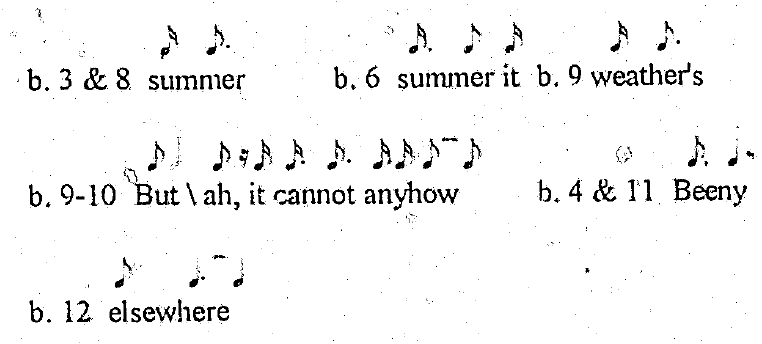
(Van der Watt, 394)
Lengthening of voiced consonants
"The word "me" (b. 6-7) containing a voiced consonant has been rhythmically prolonged and is more singable as a result."
(Van der Watt, 394)
"The tempo indication is Andante [quarter note equals] c. 63. There is only a single deviation from this tempo indication:"
Bar no. |
Deviation |
Bar no. |
Return |
Suggested reason/s |
7 |
ritard. |
8 |
a tempo |
End of stanza 1, opening of stanza 2 |
"A composed ritardando is to be found at the end of the song (b. 11-14), where the rhythmic movement causes the music to have a slower effect."
(Van der Watt, 394-5)
3. Pitch
Intervals: Distance distribution
Interval |
Upwards |
Downwards |
Unison |
(19) |
|
Second |
13 |
9 |
Third |
1 |
2 |
Fourth |
3 |
2 |
Fifth |
0 |
2 |
Sixth |
2 |
1 |
"There are 19 repeated pitches (or 35% of the total number), 19 rising intervals (or 35%) and 16 falling intervals (or 30%). The smaller intervals (a third and smaller) account for 44 intervals (81% of the total number) while the larger intervals (fourths and larger) account for 10 (or 19%). The fairly high incidence of repeated pitches gives the song a parlando character in arioso style. The smaller interval dominance makes the song very voice-friendly. Specific settings by means of using larger intervals, are more significant in such a very vocal context:"
Interval |
Bar no. |
Word/s |
Reason/s |
6th up |
2-3, 7-8 |
It never |
Emphasis |
6th down |
4 |
Beeny by |
Reinforce meaning |
5th down |
4 |
sea But |
Change of register |
4th up |
10 |
cannot anyhow |
Emphasis, emotional content |
5th down |
11 |
Beeny or |
Change of register, Reinforce emotional content |
Melodic curve
"A melodic curve of the vocal line is represented below. Certain words and phrases are indicated to show the relationship between the melodic curve and the meaning:"
 (Van der Watt, 395)
(Van der Watt, 395)
Climaxes
"The two vocal climaxes (F) occur at the opening of each stanza (b. 3 and 8) in each case on the word never. It is important to note that in the first case the poet does not agree with the negative statement made but with the second, uttered by himself many years later, he does agree. It is thus appropriate that the composer should emphasize both these instances."
(Van der Watt, 395-6)
Phrase lengths
"In stanza 1 rests are placed conveniently for the sake of breathing. In stanza 2 a breath will need to be taken at bar 9⁴to ensure fluent performance. Other phrasings are separated by rests."
(Van der Watt, 396)
"The first eight bars of the song are clearly in d minor but from bar nine the tonality becomes fuzzy. There is a tendency towards the flat direction and it seems to settle in D flat major and its relative minor key, b flat minor and ends surprisingly on an F major chord which creates an imperfect feeling, if not cadence in the b flat minor context. All modulations are summarized below:"
Bar no. |
From - To |
Suggested reason/s |
5² |
d - g |
Support the text: "she saw it look as drear" |
6¹ |
g - d |
Support the text: "Summer it seems to me" |
9 |
d - D flat\b flat |
Emotional trauma supported |
"The song contains numerous instances of chromaticism which are summarized below:"
Bar no. |
Beat |
Chromaticism |
Chord |
Function |
2 |
1 |
B & A flat |
ii° |
Prelude - anticipate mood |
5 |
2 |
E flat |
d: iv⁷ |
Support text: "look as drear" |
5 |
3 |
F sharp |
d; V⁶⁵\iv |
Support text: "look as drear" |
5 |
4 |
D flat |
d; vi⁶₄ |
Support text: "look as drear" |
9 |
1 |
A flat |
d: V altered |
Text related - despondency |
9 |
3 |
D - cambiata |
D flat: ii⁶ |
Text related - despondency, harmonic sequence |
10 |
3 |
B double flat |
D flat: iv⁶ |
Support text: "anyhow" |
13 |
1 |
D flat |
F: vii° |
Postlude - reinforce tragic mood |
HARMONY AND COUNTERPOINT
"There is a set of second inversion chords which follow one another in bars 3⁴- 4² (V⁶₄, iv⁶₄ and III⁶₄). There is also a downward harmonic sequence in bars 9 - 10 which enhances the sense of loss and isolation that is suggested in the poem."
(Van der Watt, 396)
Non-harmonic tones
"There are two prominent non-harmonic tones, namely the appoggiaturas on bars 2¹ and 13¹. These are parallel, one in the prelude, the other in the postlude. Both occur on a diminished chord which sounds against a pedal note (A and F respectively). Their semantic function is to create a sense of longing and their structural function is to establish unity and balance."
(Van der Watt, 396)
Harmonic devices
"There are pedal notes in bars 2 and 13 which help to create dissonance against an established root not. There are also tones added to certain triads in bars 2¹, 9¹, 11¹ and 13¹. These have been discussed in earlier sections."
(Van der Watt, 397)
Counterpoint
"There are two brief exchanges of material between piano and voice:"
Bar 4³-⁴ Piano - 4⁴- 5² Voice |
Bar 7²-⁴Piano - 7⁴- 8³ voice |
"These serve as subtle enhancement of unity. In the piano part internally, there is a single imitation in bar 5¹-²(alto) and 5³-⁴(tenor) with the same basic function."
(Van der Watt, 397)
"Loudness variation is given in the following summary:"
 (Van der Watt, 397)
(Van der Watt, 397)
FREQUENCY
"There are 15 indications in the 14 bars which means that on average each bar contains an indication. In reality some bars do not contain indications while others contain two or three. There are no separate indications for the voice which implies that the voice should follow the indications given in the piano part."
(Van der Watt, 397)
RANGE
"The lowest level indication, p, occur in bars 2⁴, 8, and 12 and the loudest level indication, f, occurs on bar 6³ at the emotional climax of the song: "Summer it seemed to me" when the poet was in love and had not a care in the world."
(Van der Watt, 397)
VARIETY
"The indications used are:

(Van der Watt, 397)
DYNAMIC ACCENTS
"Few dynamic accents are used. Three portamento accents emphasize individual notes in bars 7², 12² and 13¹. A single stronger accent (>) occurs on the appoggiatura in bar 2 which has already been discussed."
(Van der Watt, 397)
"The density varies loosely between one and six parts including both piano and voice. The thickness of the piano part is represented in the following table:"
No. of parts |
No. of bars |
Percentage |
1 parts |
1 |
7 |
4 parts |
12 |
86 |
5 parts |
1 |
7 |
"The four-part texture clearly dominates in the song and is used rather than a thinner texture which might have been more appropriate for the sake of a more dissonant harmonic language. The interlude (b. 7) thins out to a single melodic line and is the result of the waning emotional surge of the preceding bars. The implication is that the poet's vivid recollection of his love-state has virtually faded to nothing but a faint memory - a single melodic line. The five-part texture in bar nine supports the text in the expression of the heavy despondency the poet feels in the absence of his beloved; a five-fold heaviness."
(Van der Watt, 397-8)
"The structure of the song is represented in the following table:"

"The song has a varied strophic structure even though the second stanza is modified significantly from bars 9 -12. The similarity between bars 2 and 13 is judged insufficient to establish a ternary form, though the hint certainly exists."
(Van der Watt, 398)
7. Mood and atmosphere
"The mood of the song is bleak and sorrowful with a faint reference to a joyous time somewhere way back in the past. The mood becomes darker and more melancholy after bar 12 when the reality of the absence of the beloved is fully realized. This darker turn is brought about by an unstable tonality, stronger dissonance through chromaticism and a low vocal register."
(Van der Watt, 398)
General comment on style
"The style of vocal writing is sympathetic towards the voice (81% smaller intervals) and a parlando or arioso style with a high incidence of repeated pitches is characteristic. The harmonic language contains a number of interesting chord constructions, mostly enhancing dissonance for the sake of supporting the text. The tonal vagueness in bars 9 -14 plays a significant role in creating the melancholy mood in this particular section. The song has a strong sense of rhythmic coherence due to the use of prominent rhythmic motifs. The varied strophic form helps, furthermore, to create unity."
(Van der Watt, 398)
Unpublished Analysis Excerpts
The following is an analysis of It never looks like Summer by Mark Carlisle. Dr. Carlisle extended permission to post this excerpt from his dissertation on September 7th, 2010. His dissertation dated December 1991, is entitled:
Gerald Finzi: A Performance Analysis of A Young Man's Exhortation and Till Earth Outwears, Two Works for High Voice and Piano to Poems by Thomas Hardy
This excerpt begins on page fifty-eight and concludes on page sixty-four of the dissertation.
Comments on the Poem
"The words "Boscastle, 8 March, 1913" are inscribed beneath this poem, indicating it was written a mere three months after the death of Emma Gifford. Hardy retained fond and loving memories of his first wife, even though their marriage had disintegrated in its later years. He blamed her rejection of him on an "aberration," or a mild form of mental illness, and chose instead to remember her as he had first met her-vivacious, charming, beautiful, and "full of life." Shortly after her death, Hardy returned to Cornwall to revisit the scenes of his courtship with Emma, and it was there that this poem was written. Boscastle is a small village in Cornwall, approximately fifteen miles from Launceston, and about half a mile from the Cornish coast. Nearby is Beeny Cliff, where Hardy and Emma stood on August 22, 1870, during the idyllic days of their courtship. It was there that Emma spoke the words Hardy quotes in the first two lines of this poem. "It never looks like summer" is one of the 159 poems contained in Moments of Vision, which was published in 1917. Poems about Emma and their life together permeate the entire opus, and Hardy's mixed emotions regarding her death are evident throughout. Realizing the personal nature of these poems, Hardy wrote in his journal: "I do not expect much notice will be taken of these poems: they mortify the human sense of self-importance by showing, or suggesting, that human beings are of no matter or appreciable value in this nonchalant universe."" (Hardy, 408-9) (Carlisle, 58-9)
"This is the shortest song in the set, lasting a mere fourteen measures, but through primarily harmonic means poignantly represents the poet's deep sadness at the loss of a loved one while remembering their moments together on Beeny Hill. The song contains two clear sections that delineate the two brief poetic stanzas suggesting an antecedent/consequent relationship. Each section begins with the same melodic motive in the vocal line, but beyond this motive, there is little harmonically or melodically that is similar between the two sections. The opening meter of 4/4remains constant from beginning to end, as does the relative thinness of texture. Except for one or two noticeable spots, the rhythmical elements of the piece remain in basically eighth-note, quarter-note movement, following closely the rhythmical cadences of the poetry." (Carlisle, 59-60)
"The song opens in the key of D minor, and remains for the most part in this key until measure 9, at which time this tonal framework is broken down. Although no other key area is fully established during the remainder of the song, B flat-minor is strongly indicated in the closing six measures. A sense of tonal ambiguity is particularly noticeable in the last two measures when Finzi concludes the piece with an F-major chord, the dominant of B flat-minor." (Carlisle, 60)
"The first section of seven measures opens with a piano introduction of two measures that outlines a short, unifying melodic motive heard in the vocal line in measure 2-3, and again in both piano and voice in measures 7-8. The structure of this melodic motive, with its mixture of conjunct and disjunct motion, is such that it allows for an expressive stressing of the most important words in the opening poetic sentence, those being 'never' and 'summer.' These devices, along with the use of minor keys, provide the listener with a sense of resolved sadness as felt by the poet (see Example 5)." (Carlisle, 60)
"Example 5. 'It never looks like Summer,' measures 1-4." (Carlisle, 61) |
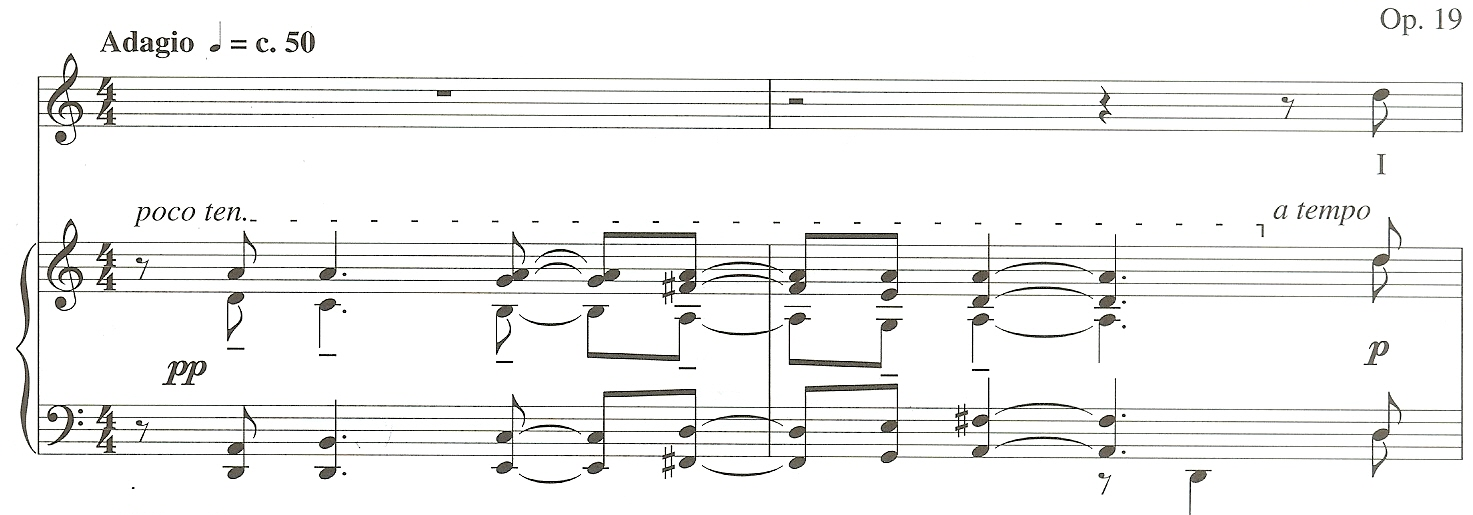

"Measures 5 and 6 offer a brief but noticeable change in melody, harmony, and rhythm, as the poet, for the only time in this poem, expresses a positive aspect of his reminiscence. The words 'But though she saw its look as drear, Summer it seemed to me' elicit from Finzi a conjunct, ascending vocal melody of increasing energy that is underscored beautifully with chromatic harmony in measure 5 to highlight the word 'drear.' The B flat-minor chord underlying this word foreshadows the shift to a new key. The chromatic effect of this chord is heightened by the fact that it is preceded by a D-major chord that shares no common tones with B flat-minor. Sixteenth-note patterns in the accompaniment and a continued rising melodic line add musical excitement to measure 6, enhancing the poet's momentary sense of reminiscent pleasure. However, a V chord in measures 6-7 to end the first section creates a sense of tension and uncertainty in that feeling of pleasure. This tension is resolved in measure 8 by bringing both music and listener back to the original melodic motive, and the poet back to his reality of sadness." (Carlisle, 61-2)
"Although the melodic motive returns in measure 8 in its brief, original form, the vocal melody throughout the remaining measures is primarily of a descending nature, in reflection of the poet's deeply felt unhappiness. Mild chromaticism in measures 9-11 provides a certain sense of tension and melancholy to this section, but the chromaticism even here is not intensely dissonant. Rather, it softly expresses the poet's realization that his love is gone forever, and that for the time being the inherent brightness and enjoyment of summer can no longer be found. The important final words are also highlighted by the momentary rhythmical change in measure 11 to half-note chords from the primarily quarter-note, eighth-note movement heard throughout the rest of the piece. This change is particularly effective here, for it provides a subtle but important means of expressing the concept that the enjoyment of life, as understood through the metaphor of summer, can no longer be felt by the poet 'On Beeny, or elsewhere!'" (Carlisle, 62)
"The final two measures provide the only unusual twist tot he song, which in truth creates a more incongruous ending than in some of Finzi's other songs. Rather than returning to the original key of D minor and continuing the sense of subdued sadness, Finzi chose to end the piece with a resolution to F major, the dominant of B flat-minor. The most plausible explanation for this ending is that Finzi wanted to express a sense of uncertainty. However, the fact that he used a major chord might imply that the wait for his grief to subside was not entirely an unpleasant one." (Carlisle, 62-3)
Comments about Performance
"There are few performance difficulties with this song, as it represents one of the most accessible of all of Finzi's output. Tempo and dynamic markings are few, and most seem sensible. Tempo is indicated as [quarter note] = c. 63 (Andante), quite appropriate for this song, and does not need to deviate much until the very end. While it may not be wise to suggest that every singer, regardless of interpretive ability, start the opening line at a dynamic level of piano, this can create a very effective beginning if properly done. It is also particularly important for both singer and pianist to observe the crescendo in measures 5-6 in order to provide the necessary intensity to the textual line. However, a tempo change is not marked here, nor is it needed, because the change from predominantly quarter and eighth-note movement to sixteenth-note sets provides a built-in sense of increased energy. Finally, although there are no tempo markings for measures 10-11, the performers should incorporate a flexible but gentle ritardando in order to provide the necessary sensitivity and expressiveness inherent in the final words of this song." (Carlisle, 63)
"This is by far the easiest piece in this set from a technical and musical standpoint. The range is quite short, an octave of f to f¹, and the tessitura is also one of the lowest of any of Finzi's songs for high voice. While a certain level of ability is necessary, the song is not difficult to interpret. This is a piece that would be well-suited to a young tenor who still has a limited vocal range, but at the same time has a sensitivity to poetry somewhat beyond what is customarily found in young male singers. It may be slightly beyond the capabilities of an undergraduate freshman, but should serve well the repertoire needs of a sophomore level student or beyond with the above mentioned characteristics." (Carlisle, 64)
Unpublished Analysis Excerpts
The following is an analysis of It never looks like summer by Leslie Alan Denning. Dr. Denning extended permission to post this excerpt from his dissertation on September 8th, 2010. His dissertation dated May 1995, is entitled:
A Discussion and Analysis of Songs for the Tenor Voice Composed by Gerald Finzi with Texts by Thomas Hardy
This excerpt begins on page eighty-two and concludes on page eighty-three of the dissertation.
"The fifth song of Till Earth Outwears provides yet another stark contrast to the preceding song within the set. Finzi's 'It Never Looks Like Summer' was inspired by Hardy's short two-stanza poem 'It Never Looks Like Summer Here' written in Bocastle on March 8, 1913, and later published in his Moments of Vision. The text revolves around the feelings of a jilted lover. Finzi's song had existed as a fragment, forgotten until his final year when he managed to finish a number of early unfinished attempts. Finzi's wife Joy described his reaction to the poem in her February 1956 journal entry."
(Denning, 82)
"On reading 'It never looks like summer here' [Gerald] instantly set it. A little one but beautiful... Later this evening: 'It's extraordinary how the mind works - quite extraordinary.' On looking through old musical notes he came on a page with sketches for the first line of 'It never looks like summer here.' When the first line sprang instantaneously after reading it this afternoon, it was quite unknown to him that he had previously worked at it over twenty-five years ago. The line written today had the same shape and fall as the previous germ_ and was obviously the completed idea after twenty odd years. 'If one doesn't live long enough one can't complete the hundreds of musical ideas waiting final shape." (Banfield, 287) (Denning, 83) |
"In the key of F-major 'It Never Looks Like Summer' benefits from both cohesive form and a general lyric appeal. Unlike many of his compositions which often appear fragmentary, it is set to sound like a single musical paragraph with an ongoing sense of mood and melodic contour with less than a measure of musical pause between measures. Finzi is much more dedicated here to the lyric lullaby-like line of the voice (musical Example 24)."
(Denning, 83)
Example 24: It Never Looks Like Summer, Measure 1-4." |
